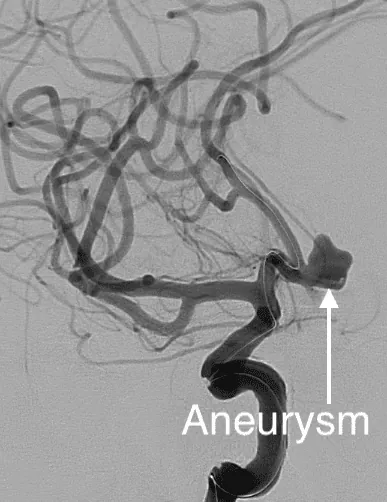Introduction to brain aneurysms
Overview of what brain aneurysms are, their causes, risks, and who is most affected.
What is an aneurysm?
An aneurysm is a bulge in the wall of a blood vessel caused by a small area of weakness (fig. 1). Aneurysms can occur in various parts of the body, but one of the most common locations is the brain. These are known as intracranial or cerebral aneurysms. Some aneurysms have the potential to rupture which can result in bleeding around the brain called subarachnoid haemorrhage.
Brain aneurysms most commonly affect middle aged and older adults with a higher prevalence in women. They are extremely rare in children. The cause of a particular aneurysm usually is unknown, although some individuals have a genetic predisposition to developing them. Aneurysms can also rarely develop after certain infections or trauma.

What is the prevalence of brain aneurysms?
Brain aneurysms are present in about 3% of the population (3 in 100 people). There are some factors that increase the risk of developing a brain aneurysm:
- Family history of brain aneurysm or subarachnoid haemorrhage (bleeding around the brain)
- Atherosclerosis: This is a condition characterised by the buildup of plaque in the arteries. It is associated with an increased risk of brain aneurysms.
- Smoking: This can result in damage to the blood vessels due to chemicals inhaled.
- High blood pressure: This causes greater pressure on the walls of blood vessels.
- Female gender
- increased Age
- Autosomal Dominant Polycystic Kidney Disease (ADPKD): This is a genetic condition leading to the development of multiple cysts in the kidneys. walls o bloodIt is also associated with brain aneurysms.
- Sickle cell disease: This is a disorder of the red blood cells that is also associated with brain aneurysms.
Are brain aneurysms dangerous?
Many aneurysms are benign, causing no symptoms and never rupturing. However, some do rupture, leading to life-threatening bleeding around the brain known as subarachnoid haemorrhage. Rarely, unruptured aneurysms cause symptoms such as impaired vision, seizures, or strokes. These symptoms result from inflammation, pressure on nearby brain structures, or the formation of blood clots. Unfortunately, there is no test that can reliably predict which aneurysms will rupture or cause symptoms, though certain factors are known to increase the risk:
- Aneurysm size: Larger aneurysms carry a higher risk.
- Location: Aneurysms in the posterior circulation (e.g. basilar artery) are more prone to rupture.
- Growth over time: Increasing size on follow-up imaging suggests higher risk.
- Previous rupture: Patients who have had one ruptured aneurysm are at higher risk of another rupturing.
- Family history: A strong family history of aneurysmal subarachnoid haemorrhage increases risk.
- Smoking: Significantly associated with both aneurysm formation and rupture.
- Hypertension: High blood pressure is a known risk factor.
- Age and sex: Rupture risk increases with age and is more common in females.
- Aneurysm shape: Irregular or lobulated shapes are more likely to rupture than smooth, round ones.
References
Vlak MH, Algra A, Brandenburg R, Rinkel GJ. Prevalence of unruptured intracranial aneurysms, with emphasis on sex, age, comorbidity, country, and time period: a systematic review and meta-analysis. Lancet Neurol. 2011 Jul;10(7):626-36.
Juvela S. Prevalence of and risk factors for intracranial aneurysms. Lancet Neurol. 2011 Jul;10(7):595-7. doi: 10.1016/S1474-4422(11)70125-9. PMID: 21641283.
Aneurysm Brain aneurysm Cerebral aneurysm